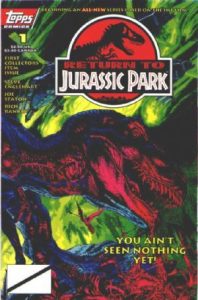After the mostly ridiculous “Raptor” trilogy (a.k.a. “Jurassic Park Adventures”), Topps Comics’ “Jurassic Park” saga got a nudge upward in quality with the nine-issue “Return to Jurassic Park”(1995-96), which consisted of two major arcs.
“Raptor” trilogy writer Steve Englehart returns for Issues 1-4, which I’ll label the “Green Flame” arc. While his trademark of rushed “throw it at the wall” storytelling is still in place, the arc has several elements that give it an edge over the “Raptor” material. In an interesting premonition of Michael Crichton’s second novel, which would come out later in 1995, Englehart shows that Isla Nublar has become a Lost World since we last checked in on the island in “Raptor” Issue 1.
As part of its Green Flame project, the corrupt U.S. military (or a corrupt spinoff group of military men – it’s not made clear) takes down the containment walls of Jurassic Park without John Hammond’s knowledge. The idea is to let the park go back to nature and provide a natural protection for the secret project (which, like the identity of its perpetrators, is left unexplained). Starring Grant, Sattler, Muldoon and some new characters, the yarn expands the comics’ roster of dinosaurs and lifts some scenes from Crichton’s novel that didn’t make it into the movie:
- In Issue 1, Edgar (Hammond’s InGen henchman) throws stones at a stegosaurus to drive it off, like Tim does in the book.
- In Issue 2, the group is attacked by cearadactyls, as Grant and the kids are in the book.
- In Issue 3, the group is attacked by a Tyrannosaurus rex on the river, as Grant and the kids are in the book.
While it’s a shame the “Green Flame” arc was cut short (it concludes with “The End. For Now.”), I’m not too heartbroken since the next four issues – which I’ll call the Abby and Derrick arc – are superior. In “Heirs to the Thunder” (Issues 5-6), set concurrently with the movie, writers Tom and Mary Bierbaum introduce a pair of Jurassic Park geneticists — the headstrong Abby and the along-for-the-ride Derrick – who get on the wrong side of a mad scientist. His genetically engineered “dinosaurs of hyperintelligence” — including a “watchdog-sized triceratops” — are an amusing parallel to the new dinosaur we’ll see in “Jurassic World.”
Issues 7-8 are among the most inconsequential “Jurassic Park” comics — featuring a he-said, she-said between Abby and a soldier accusing each other of taking photos of the park – but also the most lighthearted fun. We see a bevy of dino species as Abby and Derrick return to the park during the time of the “Raptor” saga, when General West is supervising the clean-up.
“Return to Jurassic Park” wraps with Issue 9, “Jurassic Jam,” which chronicles an earlier snafu in the park, this time caused by rats eating through cables (now THAT’S chaos theory). Like “Jurassic Park” Issue 0, we get a taste of Nedry’s “woe is me” attitude, and we see an encounter that explains why Muldoon respects the T-rex. However, Muldoon’s clocking of velociraptors’ cross country meets remains unchronicled.
1995’s “Jurassic Park” Annual likewise tells of a pre-movie mishap at the park, this one caused by an investor’s daughter, whose pet ferret gets loose and causes dino stampedes. The annual’s other yarn is darker, as Costa Rican bikers take on dilophosaurs that had reached the mainland when their eggs blew ashore. In a continuity oddity, writer Neil Barrett Jr. tells us “the dinosaurs are all gone now” from Isla Nublar. Most likely, he confused the movie/comics continuity – where the dinosaurs remain on the island, overseen by the U.S. military – with that of Crichton’s novel, where the island is napalm-bombed.
Topps would go on to do the “Lost World” movie adaptation in 1997, but this batch marks the end of its original comics. As we leave the Topps Comics continuity, Muldoon is alive, Isla Nublar (now a Lost World of sorts) has been taken over by military types working on a secret project, a brood of velociraptors is loose in South America and one dilophosaurus is loose in Costa Rica. This puts the world in similar shape to the novel continuity, where compys and raptors (“Jurassic Park”) and several big herbivorous dinosaurs (“The Lost World”) are on the mainland, but in worse shape than the movie-only continuity, where there are no confirmed dinos on the mainland (although it’s possible some raptors were on the boat hauling the T-rex in “The Lost World”).


